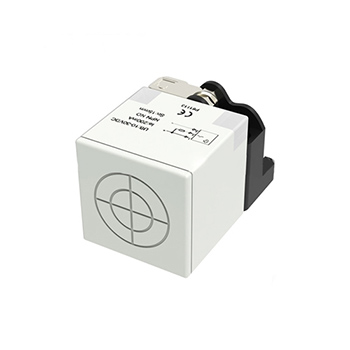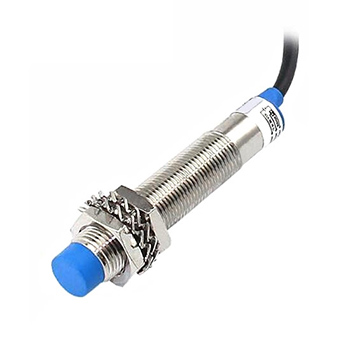What are the Types of Proximity Sensor?
Proximity sensor is a general term for sensors that replace the contact detection methods such as limit switches and aim to detect without touching the detection object. The movement information and presence information of objects can be detected and converted into electrical signals.
As proximity sensor is so important, today we are going to introduce two types of proximity sensor. We hope that you can know the specialties of two types of proximity sensor.
Inductive Proximity Sensor
The inductive proximity sensor consists of a high-frequency oscillation circuit, a detection circuit, an amplifying circuit, a shaping circuit and an output circuit. The sensing element used for detection is the detection coil, which is an integral part of the oscillating circuit.
When the detection coil is connected to alternating current, an alternating magnetic field is generated around the detection coil. When the metal object approaches the detection coil, the metal object will generate eddy current and absorb the magnetic field energy, so that the inductance L of the detection coil changes. Thereby, the oscillation frequency of the oscillation circuit is reduced, and the oscillation is stopped. The two states of oscillation and vibration stop are converted into switching signal output by the monitoring circuit.
It should be noted that, like the capacitive proximity sensor, the measured object detected by the inductive proximity sensor is also a metal conductor, and non-metallic conductors cannot be measured by this method. Amplitude changes vary depending on the type of target metal, so the detection distance also varies depending on the type of target metal.
Specialties of inductive proximity sensor
- Since the detection can be performed in a non-contact manner, the detection object will not be worn or damaged.
- Since the non-contact output method is adopted, the life extension has no influence on the life of the contact point (except the magnetic type).
- Different from the light detection method, it is suitable for use in environments such as water and oil, and it is hardly affected by the detection object like stains, oil, water etc. In addition, Teflon shell type and products with good chemical resistance are also included.
- Compared with contact switches, high-speed response can be achieved.
- Compatible with a wide temperature range.
- Not affected by the color of the detected object, it is hardly affected by the surface color, etc.
- Different from the contact type, the sensors will be affected by the influence of the surrounding temperature, surrounding objects, and the same type of sensors, including the inductive type and the electrostatic capacitance type. Therefore, for the setup of the sensors, mutual interference needs to be considered. In addition, in the inductive type, the influence of surrounding metal needs to be considered, while in the electrostatic capacitance type, the influence of surrounding objects needs to be considered.
Capacitive proximity sensor
Capacitive sensors are constructed from many different media, such as copper, indium tin oxide (ITO), and printing inks. Copper capacitive sensors can be implemented on standard FR4 PCBs as well as flexible materials. ITO allows up to 90% transparency for capacitive sensors (for one layer solutions such as touch phone screens).
Both the size of the capacitive sensor and the spacing relative to the ground plane are very important to the performance of the sensor.
The type of ground plane used is also very important. Since the parasitic capacitance of the sensor is related to the path of the electric field to ground, it is important to choose a ground plane that limits the concentration of electric field lines in the absence of conductive objects.
Specialties of Capacitive Sensors
- Good temperature stability. The capacitance value of a capacitive sensor is generally independent of the electrode material, which facilitates the selection of materials with low temperature systems. Since it generates very little heat, it has little effect on stability. Resistive sensors have resistance and it can generate heat after being energized. Inductive sensors have copper losses, magnetic flux and eddy current losses, etc., and are prone to zero drift due to heat.
- The structure is simple. Capacitive sensors are simple in structure, easy to manufacture, easy to ensure high accuracy, and can be made small for some special measurements. They can work in harsh environments such as high temperature and strong magnetic fields, and they can withstand large temperature changes, high pressure, high shock overload, etc. Capacitive sensors can measure ultra-high temperature and low dropout voltage, as well as magnetic work.
- The dynamic response is good. Due to the small electrostatic attraction between the plates with electrodes (about 105N). Capacitive sensors therefore require little energy and can be made very small and thin due to their moving parts. Therefore it is very light in weight. The natural frequency is high, the dynamic response time is short, and it can work at frequencies of several megahertz, which is especially suitable for dynamic measurements. And because of its low dielectric losses, it can be powered by higher frequencies. The system has a higher operating frequency. It can be used to measure rapidly changing parameters.
- Non-contact measurement that can achieve the average effect. For example, non-contact measurement of vibration or eccentricity of rotating shafts, radial clearance of small ball bearings, etc. When using non-contact measurement, the capacitive sensor has the function of averaging, which can reduce the influence of the roughness of the work surface on the measurement. In addition to the above advantages, capacitive sensors also have a small electrostatic attraction between the electrode plates, so the input and input energy is extremely small. It can measure extremely low pressures, as well as small accelerations, displacements, etc. It can also be made very sensitive, high resolution and sensitive to displacements of 001m or even smaller. Due to its low dielectric losses, the zero residue when connecting differential structures in bridges is very small. Therefore, high magnification of the circuit is allowed, and the instrument has high sensitivity.

